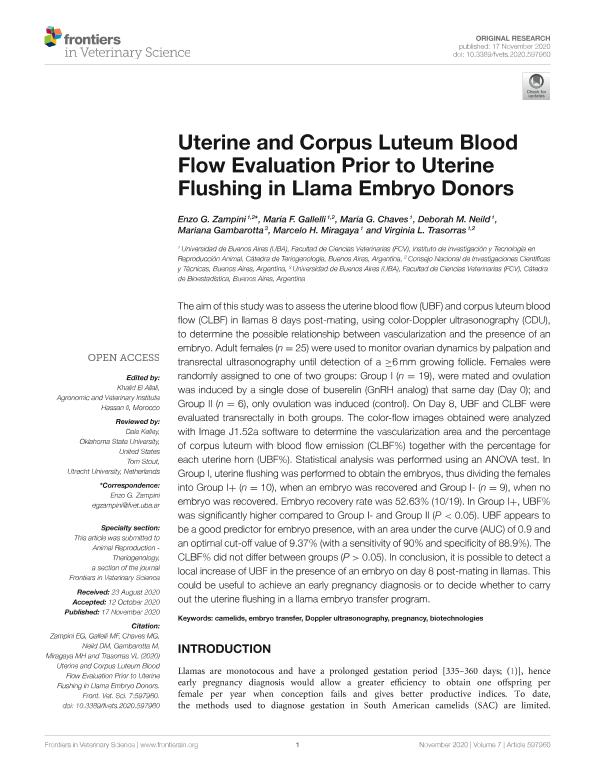Artículo
Uterine and corpus luteum blood flow evaluation prior to uterine flushing in llama embryo donors
Zampini, Enzo German ; Gallelli, Maria Florencia
; Gallelli, Maria Florencia ; Chaves, María Graciela; Neild, Deborah M.; Gambarotta, Mariana; Miragaya, Marcelo H.; Trasorras, Virginia Luz
; Chaves, María Graciela; Neild, Deborah M.; Gambarotta, Mariana; Miragaya, Marcelo H.; Trasorras, Virginia Luz
 ; Gallelli, Maria Florencia
; Gallelli, Maria Florencia ; Chaves, María Graciela; Neild, Deborah M.; Gambarotta, Mariana; Miragaya, Marcelo H.; Trasorras, Virginia Luz
; Chaves, María Graciela; Neild, Deborah M.; Gambarotta, Mariana; Miragaya, Marcelo H.; Trasorras, Virginia Luz
Fecha de publicación:
17/11/2020
Editorial:
Frontiers Media S.A.
Revista:
Frontiers in Veterinary Science
e-ISSN:
2297-1769
Idioma:
Inglés
Tipo de recurso:
Artículo publicado
Clasificación temática:
Resumen
The aim of this study was to assess the uterine blood flow (UBF) and corpus luteum blood flow (CLBF) in llamas 8 days post-mating, using color-Doppler ultrasonography (CDU), to determine the possible relationship between vascularization and the presence of an embryo. Adult females (n = 25) were used to monitor ovarian dynamics by palpation and transrectal ultrasonography until detection of a ≥6 mm growing follicle. Females were randomly assigned to one of two groups: Group I (n = 19), were mated and ovulation was induced by a single dose of buserelin (GnRH analog) that same day (Day 0); and Group II (n = 6), only ovulation was induced (control). On Day 8, UBF and CLBF were evaluated transrectally in both groups. The color-flow images obtained were analyzed with Image J1.52a software to determine the vascularization area and the percentage of corpus luteum with blood flow emission (CLBF%) together with the percentage for each uterine horn (UBF%). Statistical analysis was performed using an ANOVA test. In Group I, uterine flushing was performed to obtain the embryos, thus dividing the females into Group I+ (n = 10), when an embryo was recovered and Group I- (n = 9), when no embryo was recovered. Embryo recovery rate was 52.63% (10/19). In Group I+, UBF% was significantly higher compared to Group I- and Group II (P <0.05). UBF appears to be a good predictor for embryo presence, with an area under the curve (AUC) of 0.9 and an optimal cut-off value of 9.37% (with a sensitivity of 90% and specificity of 88.9%). The CLBF% did not differ between groups (P > 0.05). In conclusion, it is possible to detect a local increase of UBF in the presence of an embryo on day 8 post-mating in llamas. This could be useful to achieve an early pregnancy diagnosis or to decide whether to carry out the uterine flushing in a llama embryo transfer program.
Palabras clave:
BIOTECHNOLOGIES
,
CAMELIDS
,
DOPPLER ULTRASONOGRAPHY
,
EMBRYO TRANSFER
,
PREGNANCY
Archivos asociados
Licencia
Identificadores
Colecciones
Articulos(OCA PQUE. CENTENARIO)
Articulos de OFICINA DE COORDINACION ADMINISTRATIVA PQUE. CENTENARIO
Articulos de OFICINA DE COORDINACION ADMINISTRATIVA PQUE. CENTENARIO
Citación
Zampini, Enzo German; Gallelli, Maria Florencia; Chaves, María Graciela; Neild, Deborah M.; Gambarotta, Mariana; et al.; Uterine and corpus luteum blood flow evaluation prior to uterine flushing in llama embryo donors; Frontiers Media S.A.; Frontiers in Veterinary Science; 7; 597960; 17-11-2020; 1-8
Compartir
Altmétricas



